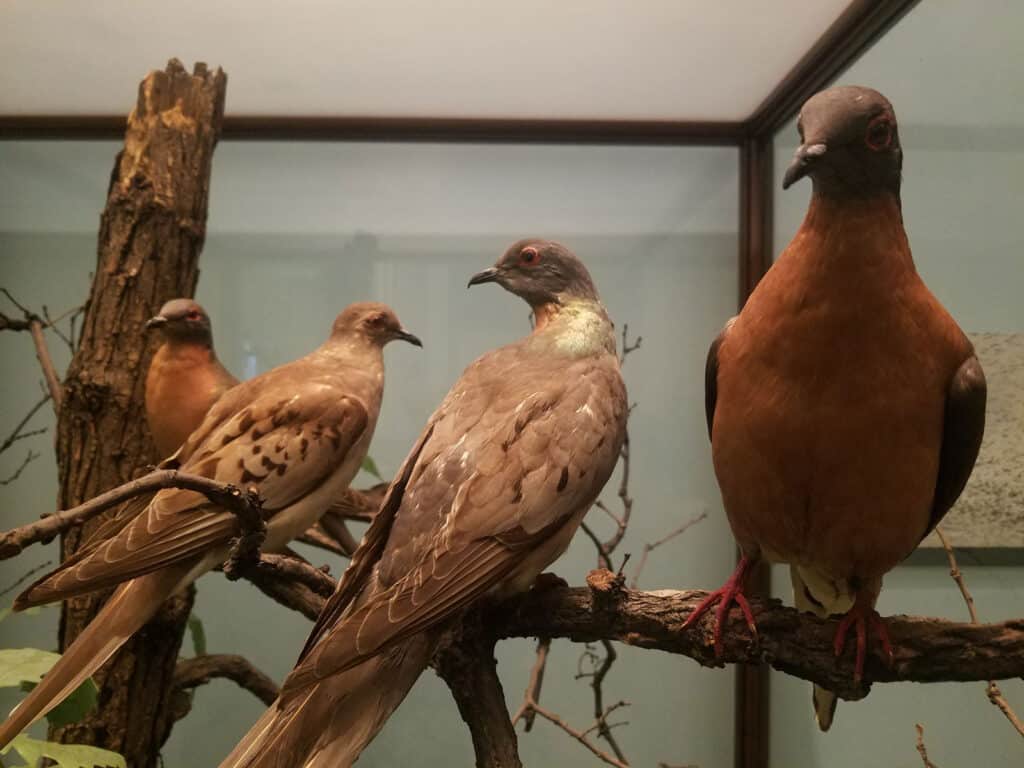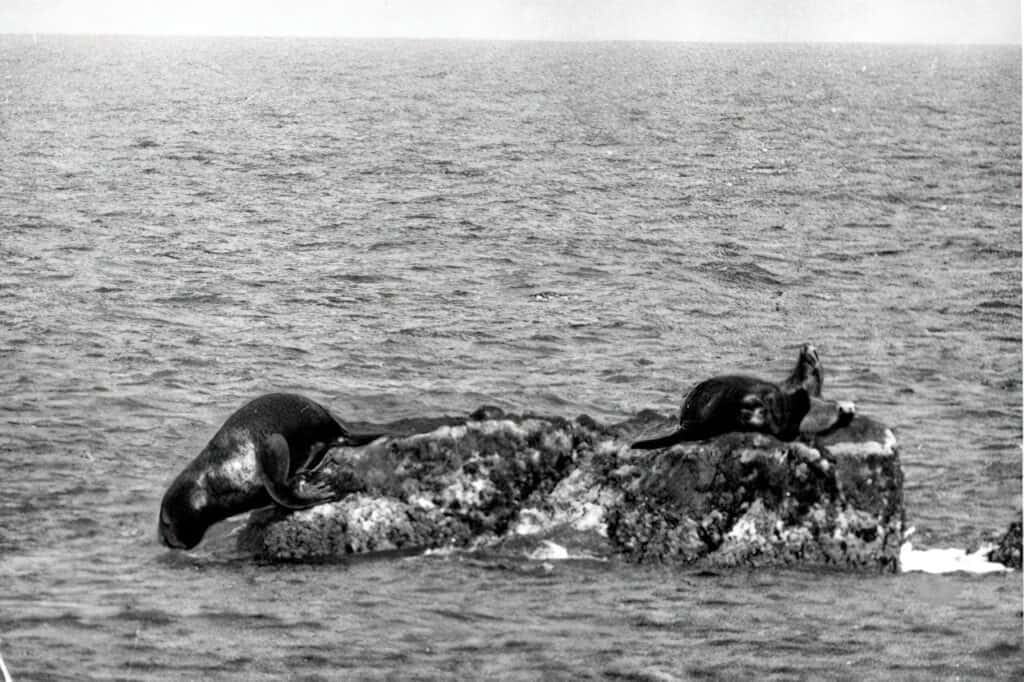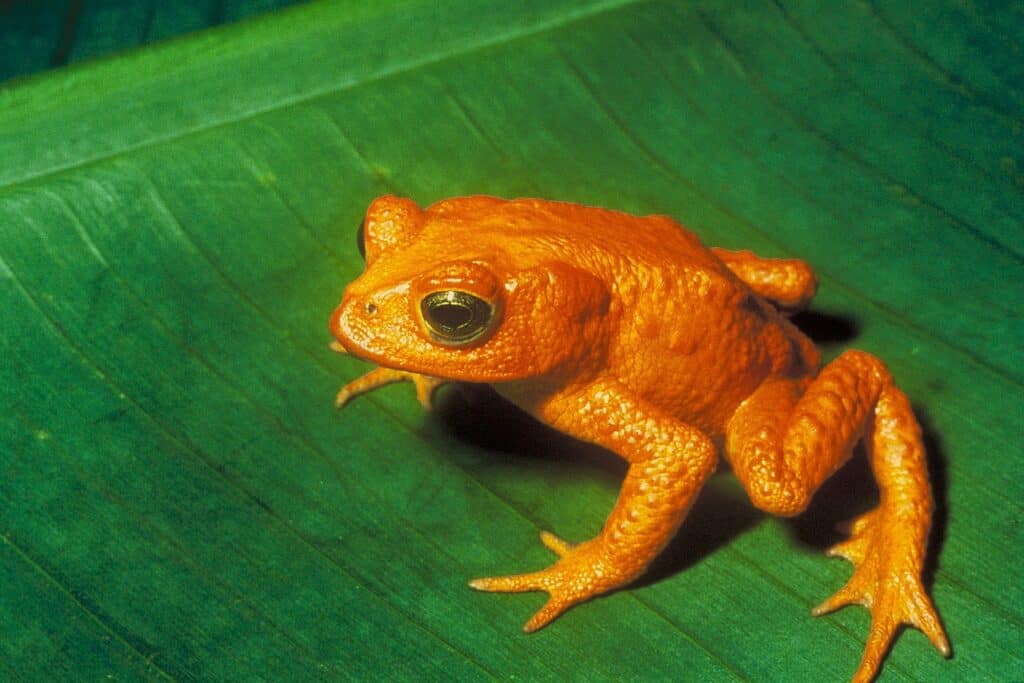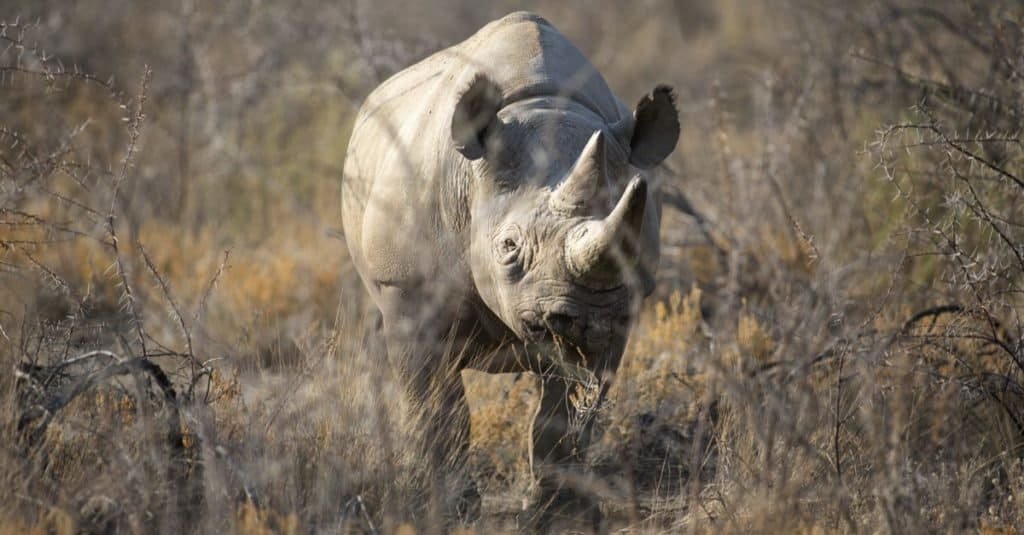
Extinction isn’t a new concept. It’s happened for millions of years. The most famous extinction event was the dinosaurs 65 million years ago. It’s not new, but recently many different species have become extinct. Here are 7 animals that have gone extinct in the past 100 years.
Passenger Pigeon

Passenger pigeons went extinct due to intensive hunting and habitat destruction.
©ChicagoPhotographer/Shutterstock.com
Native to North America the passenger pigeon (Ectopistes migratorius) was an attractive wild pigeon around 12 inches tall with a long-pointed tail and a pink tint to its plumage. It looked much like the mourning dove and was named ‘passenger’ due to its habit of ‘passing by on migration.
Reports indicate it was a tame bird and easy to catch. Unfortunately, this meant it was extensively hunted for food by Native Americans and then by colonists in the 19th century. Alongside hunting, colonists destroyed their native forest habitats to create cattle pastures. It’s said over 100 passenger pigeons could inhabit a single tree, so deforestation hit them hard.
In the wild, passenger pigeons went extinct around 1900. The final few captive birds died in the early 1910s. It’s a clear example of extinction due to human activity.
Japanese Sea Lion

The biggest male Japanese sea lions could weigh up to 1230 pounds.
©public domain – License
The Japanese sea lion, Zalophus japonicus, was an aquatic mammal that lived in the Sea of Japan, the Korean Peninsula, and the Japanese archipelago. Males reached 8 feet in length, while females were shorter at 5.9 feet. The biggest male Japanese sea lions could weigh up to 1230 pounds. Both sexes were dark grey, but the female was a lighter shade.
They bred on sandy beaches accessible to humans and were hunted to extinction in the 1900s for their fat and oils. Their internal organs were used in medicine, and even their whiskers were used to clean pipes. Some Japanese sea lions were captured for 20th-century circuses but couldn’t be replaced when they died because the species was extinct.
Tasmanian Tiger

Tasmanian tigers were carnivorous marsupials that went extinct in 1936.
©Adwo/Shutterstock.com
The Tasmanian tiger, Thylacinus cynocephalus, wasn’t a tiger at all! It was a striped carnivorous marsupial native to Tasmania, Australia, and New Guinea.
They were around the same height as a medium-sized golden retriever dog and weighed about 30 pounds. On their bellies, they had a stiff pouch to carry their young.
Tasmanian tigers hunted kangaroos, wallabies, and birds, but when settlers arrived, they started hunting their goats and sheep. This led to cash bounties. Tasmanian tigers were hunted because they were livestock predators and their stripy skins made warm clothing. The introduction of dingoes, dogs, and diseases also decimated the population.
They went extinct between 1910 and 1920, but a single Tasmanian tiger was kept in the Hobart Zoo until 1936, when it died from exposure.
Golden Toad

The golden toad was only discovered in 1964, but by 1989 they couldn’t be found.
©Bufo_periglenes1.jpg: Charles H. Smith vergrößert von Aglarech derivative work Purpy Pupple / public domain – License
Golden toads (Incilius periglenes) were part of the Bufonidae family of ‘true toads.’ Now extinct, they were endemic to Monteverde Cloud Forest Reserve, a four square kilometer of high-altitude land in Monteverde, Costa Rica.
As its name suggests, this toad was brightly colored. Both sexes were smooth-skinned, but the males were orange, and the females had a range of shades from black, red, green, and yellow. The largest females were 2.2 inches long, lived in wet burrows, and ate small insects.
This little toad was only discovered in 1964, but by 1989 they couldn’t be found. The species has been declared extinct, and experts aren’t sure what happened. Their limited range was a problem because of a severe drought in the 1980s. Climate change and a possible disease may also have contributed to their decline. This article digs deeper into what happened to the golden toad.
Sicilian Wolf

Sicilian wolves are one of the animals that have gone extinct in the past 100 years due to human persecution.
©M. Migneco / public domain – License
The Sicilian wolf (lupu sicilianu) was a subspecies of gray wolf endemic to the Island of Sicily.
It was paler than the North American gray wolf with shorter legs and only reached 27 inches at the shoulder. The fossil record indicates Sicilian wolves arrived in Sicily around 20,000 years ago via a land bridge and preyed on herbivorous mammals such as horses, deer, and pigs.
Sicilian wolves are one of the animals that have gone extinct in the past 100 years due to human persecution. They were hunted extensively in the 1920s, and sightings were rumored in the 1970s, but experts think the Sicilian wolf went extinct in 1924 when the last known wolf was killed near Bellolampo.
If you want to see a Sicilian wolf today, several stuffed specimens are on display in the Museo di Storia Naturale di Firenze in Florence, Italy.
West African Black Rhinoceros

Poachers killed West African Black Rhinoceros for their horns. Around a million were killed between 1965 and the 1990s
©2630ben/Shutterstock.com
The most recent animal that has gone extinct in the past 100 years is the West African Black Rhinoceros (Diceros bicornis longipes). This huge powerful rhino was 11 feet long and weighed up to 3000 pounds. Experts believe it was near-sighted and relied on bird alarm calls to detect danger.
Endemic to West Africa and the sub-Saharan savanna, it was a subspecies of black rhinoceros that evolved around 8 million years ago with two horns. The largest horn was over 3 feet, and the second shorter horn was around 1.6 feet. It was these magnificent horns that led to its extinction.
West African Black Rhinos were hunted to extinction because their horns were valuable in herbal medicine. Intensive poaching plummeted the species from over a million in the 1960s to a few thousand by 1995. A governmental campaign tried to save them, but it was too late. The last one was seen in Cameroon’s northern province in 2006. They were declared extinct in 2011.
Chinese River Dolphin

Chinese river dolphins used echolocation to find their way around and hunt river fish.
©Roland Seitre / CC BY-SA 3.0 – License
The Chinese river dolphin Lipotes vexillifer is better known as the baiji. It hasn’t been seen since 2002, but it was once numerous in China’s Yangtze River.
The baiji was white with a small head and poor eyesight. It used echolocation to find its way around and hunt river fish. Its beak was long and narrow with an upturned tip, so quite different from modern dolphins.
Although it’s called a dolphin, the baiji wasn’t closely related. It descended from La Plata dolphins and Amazon river dolphins 16 million years ago. Still, in the early 1900s, they were extensively hunted, then in the 1950s, net fishing became industrialized, and hydroelectricity dams changed their habitats. As a result, they began to die out. Officials have searched for years, but since 2002 baiji haven’t been seen.
Although Chinese river dolphins are listed as critically endangered, experts think they are extinct.
The animals that have gone extinct in the past 100 years are all very different, but one thing unites them. They all became extinct due to human activity. Hunting and environmental erosion are enough to destroy a species. It’s a worrisome, regular event highlighting the need to care for our world.
Summary Of The 7 Animals That Have Gone Extinct In The Past 100 Years
| Rank | Animal | Extinct Since |
|---|---|---|
| 1 | Passenger Pigeon | went extinct around 1900 |
| 2 | Japanese Sea Lion | Declared extinct in the 1970s |
| 3 | Tasmanian Tiger | last remaining tiger died in 1936 |
| 4 | Golden Toad | Last seen in 1989, declared extinct in 2004 |
| 5 | Sicilian Wolf | 1924 |
| 6 | West African Black Rhino | Declared extinct in 2011 |
| 7 | Chinese River Dolphin | Last seen in 2002, declared extinct in 2006 |
The photo featured at the top of this post is © iStock.com/EcoPic
Thank you for reading! Have some feedback for us? Contact the AZ Animals editorial team.






